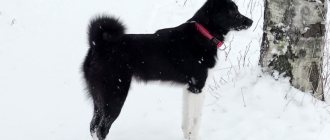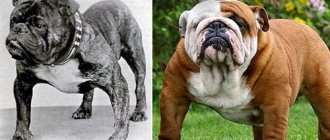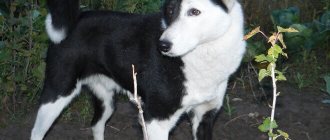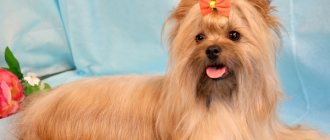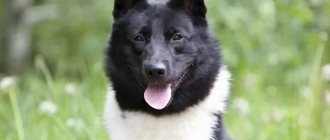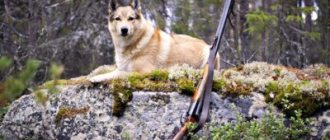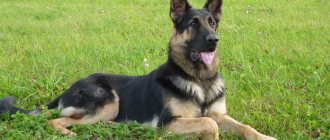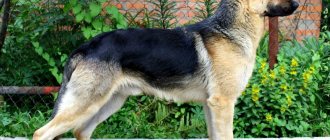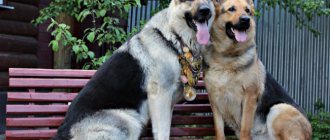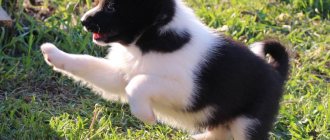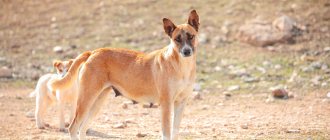Dog buyers are divided into two types. Some first create a “technical specification” for the pet: they figure out what functions it will perform, what living conditions will be provided to it - and based on these requirements, they select a breed that suits them personally. This is the best option. If you haven't chosen a friend yet, you should do just that.
The second category of future pet owners first buys the puppy they like, and then thinks about where it could be useful. This is also a good option, but provided that you do not demand the impossible from the dog. The main thing is that you and your four-legged friend are happy and satisfied with life.
And yet there are situations (for example, an urgent move to a private house ) when you want to “expand the functionality” of the dog and instill in it new, unusual skills (for example, adapt a husky for protection or teach a St. Bernard to rush at a stranger). Sometimes this is possible, most often (as in the case of the St. Bernard) it is not.
Laika dog
Author: Domsobaki · December 25, 2016
This dog breed belongs to the Spitz group. She is an excellent assistant when hunting fur-bearing animals. After the war, several dozen dog kennels were created on Russian territory, 17 of which contained only huskies.
Laika dog breed description, characteristics, character and education
There are several breeds of huskies. These include Russian-European, East Siberian, West Siberian Laikas. Native breeds include the German and Yakut Laika. European breeds include Finnish Spitz, Karelian Bear Dog, Norwegian Elkhound, etc.
Each breed has its own standards adopted by international canine organizations. Laikas have a freedom-loving character and at the same time very loyal to their owner. The dog is smart, clean, disciplined. He has an excellent sense of smell and a well-developed hunting instinct.
Raising a husky needs to be done from an early age. She is not very trainable, so it is important to teach her to follow simple commands from childhood. The relationship with the dog must be maintained in a trusting and friendly manner.
What is the Laika dog intended for, guarding a private home, hunting, description
A dog of this breed is designed to help a person in hunting. She has a wonderful sense of smell.
She pursues the animal silently, and when she finds it, she calls the hunter with a bark. Laikas are used to hunt fur-bearing animals.
The husky also has good guarding qualities. But she is not suitable as an evil watchman for a private home. This is a family friendly dog. It is better to get a Caucasian Shepherd or a Moscow guard dog for such purposes.
Laika and Husky dog differences
These are two completely different breeds. Huskies are sled dogs that are designed to transport goods and people in the snow. They are completely unsuitable for hunting, since they will consider all the prey they find to be theirs. They are also bad guards; huskies do not protect the house in which they live.
Externally, the Laika breed resembles a husky and is also used as sled dogs, but differs in that it has a well-developed hunting and guarding instinct and always defends its territory.
How much does a Laika dog puppy cost, price, where to buy
The cost of a husky puppy depends on the breed, class of the animal and the place where you will buy it. A Russian-European Laika puppy with documents from a nursery costs from ten to forty thousand rubles, an East Siberian one - from 10 to 20 thousand, other breeds cost about 15 thousand rubles. If you buy a puppy from a private owner, the cost will be from two to ten thousand rubles.
Laika dog care and feeding, hasn’t eaten for two days, doesn’t eat well, what to feed at home, can it be kept on a leash?
Dogs of this breed need at least two hours of daily walks. They need physical activity. The dog's coat should be brushed every day and bathed as needed. It is necessary to monitor your dog's diet so that it stays healthy longer.
For feeding, dry food with the addition of minerals and vitamins, raw meat, scalded with boiling water, vegetables, and dairy products are used. You should not give sweets, boiled bones, spicy, hot and smoked foods.
If the dog refuses to eat, it must be seen by a veterinarian. This may be the first sign of a serious illness.
It is better to keep huskies not on a leash, but in an enclosure, as they are very active and love freedom.
Laika dog Russian-European, West Siberian description
The Russian-European Laika is a dog of medium height (maximum height 58 centimeters), muscular and lean. The ears are erect, the tail is set high, curled into a ring. Color black and white. The coat is thick and coarse, forming a lush collar on the withers and neck.
The West Siberian Laika is slightly taller, its maximum size at the withers reaches 62 centimeters, and its weight is about twenty kilograms. The color of this breed can be very diverse: piebald, white, red, brown, gray. The coat is medium length, the undercoat is soft and lush.
On the neck and withers, the hair forms a collar. The bones are strong, the ears are erect, the eyes are oval or almond-shaped, brown in any coat color. This dog is suitable for hunting large game.
Laika dog is afraid of being shot, what to do, how to train, diseases
To use a husky for hunting, it must be trained from puppyhood, then it will not be afraid of being shot. When buying a puppy, you need to pay attention to its parents; they must have good hunting qualities. First, the dog is taught to follow simple commands, obey the owner’s voice, then pick up the scent of the hunt and chase the animal.
Laikas are healthy and hardy dogs. They can suffer from infectious diseases if they are not vaccinated on time. The most dangerous diseases are carnivore plague and rabies.
It is necessary to give your pet anthelmintic medications every four months so that he does not have parasites. Laikas may also suffer from diabetes, deafness, glaucoma, and hip dysplasia.
Source
Story
The history of huskies begins in the snowy expanses of Siberia. Where there was a place only for the small nations of the north, and each nation kept its own dog, unlike the others. This is how different breeds appeared, belonging to a single group called “Laiki”.
Depending on the way of life the people led, the tamed animal also adapted to it; nature formed in it certain qualities that were important for its life and survival in the appropriate conditions.
The hunting skills of the animals not immediately appreciated. For a long time, Siberia was not of interest to influential and noble people, being considered a snowy and unpromising region. But a man’s interest in big money led him to hunt fur-bearing animals.
It was an expensive item. Good fur was valued at all times, and such fishing, although not always legal, was very profitable. Mostly the aborigines and poachers went after the prey, but at the end of the nineteenth and beginning of the twentieth the situation changed.
The Russian nobility loved hunting very much and managed to realize how unusual and useful helpers live in the north. It is thanks to the Russian princes for their classification and passion for this breed that today we enjoy communicating with four-legged friends from the far north.
After the civil revolution, the new state that emerged from the ruins needed a large infusion of finances for its full existence. Laiki, like no one else, could become an assistant in this matter. All that remained was to establish a fishery for the extraction and processing of furs, as well as to start breeding ideal hunters. And even better - to breed new breeds that are more resilient, stronger, improve their character and make them subservient to humans.
At that time, several new varieties of huskies appeared, several of which were so successful that they were recognized throughout the world and are still popular.
Laika breeds bred in Russia:
The Russian-European breed appeared in the sixties of the last century. About ten aboriginal huskies took part in the creation of this variety. As a result, an amazing result was achieved; a talented and gifted hunter was born, with a beautiful black and white color. Official recognition occurred in 1980. The breed was entered into the Fédération Cynologique Internationale register under number 304.
Which dog is better to bring into a private home?
14 minutes to read
Dogs are brought into private homes for various reasons. Some find it easier to live under the protection of faithful four-legged bodyguards, others get watchdogs to protect their property, and others simply need a companion. To answer the question “which dog is best to bring into a private home,” you need to know for what purpose you plan to use the pet.
Which dog is better to bring into a private home - breeds and their characteristics
We analyzed the characteristics of different dog breeds that are suitable for keeping in private homes. In our material you will find a selection of the best breeds and their brief descriptions. We hope this will help you understand which breed is best for you and make your choice.
Depending on the function that the owners assign to their pet, dog breeds can be divided into several types.
Important: when deciding which dog is best to bring into a private home, have a clear idea of what you expect from your future pet.
Best qualities
A watchdog, according to dog handlers, must have a set of characteristics that will allow it to fulfill its duties. There are special breeds in which watchdog qualities are developed at the genetic level. At the same time, the concepts of watchman and security guard are not synonymous; different specifications presuppose the dominance of certain inclinations.
A guard dog will help preserve the owner’s property in a private home
For an ideal guard dog you need:
Note! Medium-sized dogs are considered the best representatives of service breeds. They can be kept even in a small local area.
The best dog breeds for guarding a private home
Which guard dog should you choose to guard a private home? Our selection of breeds will help you answer this question. The breeds are listed in alphabetical order.
Akita Inu
“The Quiet Watchman” is what these incorruptible dogs are called. Akita Inus do not raise their voice without a reason. Hereditary watchmen do not have a frightening size and appearance, but they have the proper amount of aggression in their character and have remarkable strength.
Alabai
Perhaps this is the best guard dog breed for guarding a private home. There is not a person who would want to enter the area with Alabai in a sober mind. This large guard dog is extremely unfriendly to everyone who appears in the protected area, he defends it to the last.
Dogue de Bordeaux
You can immediately feel sorry for everyone who tries to break into yours - not a single burglar will escape the strong grip of this dog. Dogs are used to guard household property; they are not suitable as guards on the property.
Bullmastiff
Strong, fearless dogs have been used since ancient times as huntsmen's assistants. They protected hunting grounds by tracking down and deterring intruders. Therefore, this breed is considered to be good watchdogs. They do not stand on ceremony with those who try to enter the territory protected by the bullmastiff - they knock them off their feet with a powerful push and hold them until the owner arrives.
Hungarian Kuvasz
The exterior of the Kuvasz does not cause trepidation among robbers. The dogs look nice and friendly, but don’t be fooled – Kuvasz are incredibly territorial dogs. They are ready to resolutely and fiercely protect the owner's property. The breed was bred to protect against large predators (wolves, bears), so it will be difficult to scare these guards.
Doberman Pinscher
Smart, strong, athletic and easily trained dogs seem to be created to guard the house. Their serious, intimidating appearance commands respect. Dobermans are very energetic, fast and determined. Nobody wants to get involved with such a dog.
Caucasian Shepherd Dog
The popular breed was bred specifically for working with sheep and protecting personal property. Physically strong large dogs command respect for their appearance. These are reliable guards who zealously guard their entrusted territory. Caucasian Shepherds are extremely intelligent and have a tendency to analyze and make quick decisions without waiting for a command.
Cane Corso
Another big and brave guard. The main purpose of this stern dog is to guard and protect. The animal is selflessly devoted to its owners. Cane Corso divides all people into two categories: “friends” and “strangers”. “Strangers” do not have a single chance to become “our own” - dogs are incorruptible! The four-legged guards act decisively, instantly attacking as soon as they detect an intrusion into their borders.
Moscow watchdog
Impressive size, boundless devotion to the owner, the ability to quickly learn, fearlessness and dedication – these are the qualities that an ideal watchman needs. The Moscow Watchdog has all these characteristics. Dogs are ready to fight any opponent to the last drop of blood.
German dog
This is the very case when the dog’s exterior performs a guard function. Its impressive size, serious appearance, and decisive look stop intruders. Great Danes are gentle with their family. They are especially kind to the youngest members of the family.
German Shepherd
Alert dogs watch even when they are resting and sleeping. They react sensitively to every rustle, boldly rush to defense, fight to the last. The German Shepherd has everything an ideal guard dog needs: speed, intelligence, endurance, power and reaction. A dog that is affectionate with its family instantly turns into an aggressive watchdog at the sight of intruders.
Rottweiler
No sane burglar would enter a house with a Rottweiler. Just looking at this muscular, powerful body becomes creepy. Rottweilers are distinguished by selfless devotion to their family and hypertrophied distrust of strangers.
Family breeds of companion dogs for a private home
If you need a canine companion, then you have a huge choice. You can have not only a miniature dog in the house, but also a pet that can live on the street, and a dog of large and giant breeds.
It is impossible to list all the breeds that families with or without children have in a private home in one material. We have made a selection of several breeds that are ideal for companion dogs.
The following breeds are suitable for owners of country cottages with spacious plots who plan to often go with their pets into the forest or to a pond.
Alaskan Malamute
The wolf-like dog wins people's hearts with its spectacular appearance and inexhaustible energy. A good-natured dog can be an ideal companion.
Aussie (Australian Shepherd)
An unpretentious dog is sensitive to its owner, needs his attention, and wants to be useful. Aussies are excellent nannies; you can leave small children with them. This breed also copes with the role of watchmen.
Boxer
This dog does an excellent job of being a loyal friend, reliable companion and fearless protector. A cheerful and friendly dog will be happy to keep his person company. He enjoys going on walks with his owner.
Drathaar
“Furry Energizers” are ready not only to accompany their owner on the hunt, but also to become his true friend. Endless love for the owner, wonderful character, sharp mind, ability to easily find a common language with children - all this is about the Drahthaar breed.
Golden retriever
A retriever will not make a watchdog, but this dog copes with the role of a companion perfectly. Good-natured dogs with a calm, friendly disposition have high mobility and endurance. You can go jogging, cycling or hiking with them.
Labrador Retriever
Labradors are the standard of a companion dog. It is these dogs that are most often imagined when they paint an ideal picture of family life. A cozy country house, a large friendly family and a Labrador lying on the porch.
Malinois (Belgian Shepherd)
An energetic dog feels great in country life. A loyal friend and companion who can, if necessary, defend the interests of the owner.
Samoyed
Samoyed dogs do not have the fame of Labradors - this is an unfortunate injustice. Samoyed owners claim that the expression “Tamara and I walk as a pair” is about their pets. They do not lag behind their owner one step and are happy to keep a person company both on a walk and at home.
Important: These breeds need constant close contact with humans; they need to be walked for a long time. Bored pets are destroyers!
Average
Which medium-sized guard dogs would be best for protecting a private home:
Boxer
A German fighting breed, which is distinguished by its charismatic appearance, athletic and muscular physique, and kind character. Easily fits into families or work teams, intuitively senses people with bad intentions. He loves children, but it takes a little effort to get him into the game.
Chases wild cats and doesn't particularly like domestic cats. At the slightest threat to the owner or his family, he rushes to defense, but does not attack as a last resort, as if biding his time . As practice shows, when you see such a dog, thoughts of attack immediately disappear. Despite its impressive muscle mass, the dog can develop high speed. At the same time, the dog is very funny and goofy with his loved ones.
Australian Shepherd
Something between a hyena and a husky. A very unusual breed, with protruding ears. The color is most often light, but there are also white or black and white options. Very friendly and calm towards other dogs and children. Doesn't like cats, but will make friends with a house cat. He is reluctant to learn commands and often reduces the learning process to a regular game.
He loves to go for walks, sometimes he breaks into the street himself. Does not require special nutrition, except that it loves fish and seafood. A good choice for those who lead an active lifestyle and walk a lot. This breed will be an excellent hunting or fishing companion, and will also serve as a nanny for your children.
Giant Schnauzer
The energy from this breed is in full swing every minute. If you are an active person, then this is a faithful and kind guard who loves children. He subtly senses the owner’s mood and does not insist on a walk if he sees that he is not in the mood.
An interesting fact is that only representatives of this breed have unique facial expressions that are very similar to human emotions. Even after a small offense, the dog feels guilty and tries to make amends for it. Does not attack domestic animals, but does not tolerate stray cats.
Chongqing
A breed from China that combines the features of a French bulldog and a pit bull. The dog is smooth-haired, the color is brown, red, brown. The character is wayward, but compromising, it can make concessions so as not to spoil relations with the owners and their environment.
Does not require a special diet or too frequent physical activity. Minimum: walks three times a week. He is not interested in street cats, but he can have a great quarrel with domestic cats. He perceives children as friends or brothers and does not attack unless provoked. He loves training and willingly learns new commands. Doesn't make noise at night and maintains discipline.
Shar Pei
Another visitor from China, with characteristic features - small, deep-set eyes and wrinkled, folded skin. The structure of the body is very powerful; considerable muscle mass is hidden under the folds. The character is calm, but to some extent arrogant.
The dog does not recognize everyone, you need to earn its respect so that it opens up and trusts you. Any food is suitable, because this breed is omnivorous. The only rule is less sweets. As for training, he shows miracles of logic, memory and learning speed. He loves cats and children, but in a conflict situation he shows his character.
Shar Pei, despite many disputes, is an excellent guard; if you are in danger, then Shar Pei will fight until his last breath!
Samoyed Laika (Samoyed)
A small fluffy animal that can protect your sleep and peace of mind. Very active and fast, he spent most of his history hunting. Can tolerate any climatic conditions. He eats only meat and does not like sweets.
He has a very positive attitude towards children and loves to play. Learns commands quickly and unquestioningly. Doesn't chase cats and is very friendly with other dogs. Nevertheless, he distinguishes well between “friends” and “strangers”, barks only when there is a real threat . Doesn't attack without a command unless you touch him first. Loves walks and active games in the fresh air.
The best dog breeds for farms - shepherd dogs
Farmers need service dogs that can work on their farmland just like them. Dogs living on country farms must protect the land, animals and people. For owners of livestock farms, herding breed dogs are best suited.
Anatolian Shepherd
Smart and loyal animals have been used since ancient times as shepherd's assistants and protectors from predators. They are highly territorial and make independent decisions. The breed requires professional training.
Bernese Mountain Dog
An unpretentious livestock guardian, he is distinguished by his endurance and incredible performance. In his free time from herding work, the dog will be happy to keep you company, ride your children in a sled, and swim with you in the pond.
Welsh Corgi
This little short-legged dog is an incredibly energetic and determined shepherd. He deftly manages a flock of sheep or a herd of cows. Corgis are excellent companions, positive and affectionate pets.
Komondor
These large shepherd dogs have a unique appearance that allows them to stand out in a flock of sheep. Brave and determined dogs fearlessly protect their animals and fiercely rush at predators. Their unusual coat with dreadlocked braids saves shepherd dogs from animal bites, heat and cold.
Maremmo-Abruzzese Shepherd Dog
Maremma is a shepherd dog from Italy. While protecting his herd, he can engage in mortal combat with wolves. It is an ideal guardian for animals and people living on the farm.
Another lover of the dreadlocks hairstyle. Small shepherd dogs resemble the Komondor breed in appearance. The nimble dogs deftly handle sheep, jumping from the back of one sheep to another.
Dog breeds that can live outside in winter
The best guard dog for a private home is a dog that lives on the street. Domestic dogs will not be able to maintain year-round round-the-clock duty, guarding the territory of the yard and household.
When answering the question: “which dog is better to have in the yard of a private house,” one must take into account the breed’s ability to withstand adverse weather conditions (frost, snow, wind).
Dogs that can live outside in winter - dog breeds:
Important: the main condition for outdoor keeping is the presence of a covered enclosure and an insulated booth.
Hunter and guard: getting to know the Russian-European Laika
For people living in the private sector, an important question is: what breed of dog should be chosen to guard the house and the surrounding area. Outbred chain bugs are quite capable of reacting by barking to a suspicious noise or silhouette, but only animals with a pronounced territorial instinct can fulfill the task of a guard and repel an intruder. Functional guard dogs have a high level of dominance, a tough character and the ability to act independently, which allows them to fearlessly, and often alone, enter into battle with a human opponent.
In addition to psychological factors, the best dog for guarding a private home should be unpretentious and resistant to weather conditions, feeling quite comfortable both in the summer heat and in the February frost. For short-haired guards in winter, a heated room is necessary: in particular, the enclosure must be securely closed from drafts, and a heater must be installed in the booth.
Laika for protecting a private home
Dog buyers are divided into two types. Some first create a “technical specification” for the pet: they figure out what functions it will perform, what living conditions will be provided to it - and based on these requirements, they select a breed that suits them personally. This is the best option. If you haven't chosen a friend yet, you should do just that.
The second category of future pet owners first buys the puppy they like, and then thinks about where it could be useful. This is also a good option, but provided that you do not demand the impossible from the dog. The main thing is that you and your four-legged friend are happy and satisfied with life.
And yet there are situations (for example, an urgent move to a private house ) when you want to “expand the functionality” of the dog and instill in it new, unusual skills (for example, adapt a husky for protection or teach a St. Bernard to rush at a stranger). Sometimes this is possible, most often (as in the case of the St. Bernard) it is not.
Nutrition
The cornerstone associated with the principle of feeding dogs is: is it better - natural or factory-made? There are pros and cons to both cases, so ultimately it will all depend on the dog. If the West Siberian Laika begins to show dissatisfaction at the sight of dry food, even premium food, then you should listen to the animal’s opinion and change the contents of the plate.
By the way, about plates. The older the individual, the less often it eats during the day. A dog that has reached one year old eats twice a day. West Siberian Laika puppies , like babies of other breeds, eat up to 5-6 times a day.
It is necessary to ensure constant access to a bowl of clean drinking water and change it every day. If we are talking about natural products, then it is worth considering a number of features:
- give your dog vitamins and microelements with food;
- know by heart the list of prohibited products;
- strictly monitor the weight of portions and regimen;
- process raw meat and fish.
If we are talking about dry food, then the best option is premium or super-premium food marked “Energy”. These products are intended for active dogs. And this is exactly who this hunter is.
Natural food consists of 35-40% proteins: raw or frozen meat, except pork, as it is fatty. Poultry meat and cooked products are also not recommended.
Meat on the bone with films is much healthier than loin or tenderloin. Breeders do not recommend boiling it, but steaming or boiling water is required. Once a week you can give your dog sea fish, sometimes pamper him with offal.
Coarse grains are acceptable. Of the fermented milk products, cottage cheese is the healthiest for huskies; the dog can consume it daily. All sweet, fried, salty, baked goods, chocolate, sausages, marinades and spicy foods are prohibited.
What breeds are not suitable for home guarding?
Of course, it is better to initially keep in mind the need for protection and choose a Moscow guard or Caucasian shepherd dog.
But sometimes the dog is already there. You are out of luck if your pet: Laika as a guard for a private home is a bad choice. Hunting dogs, despite their passion and ability to rush even at a wild boar in the forest, do not demonstrate aggression towards people.
You can try to train them to act as guards (teach them to rush at a stranger). However, this area is unnatural for the husky , and it will most likely perform its home guard Laikas and other hunting breeds (greyhounds, dachshunds) were selected by humans in order to genetically consolidate a friendly attitude towards people. When hunting, it is important that the dog loves to cooperate with humans and rushes only at animals, so for many decades, breeders have been culling puppies in order to make new generations more and more loyal to us.
An attempt to unblock aggression and direct it towards people through training and instilling anger (which is what is needed to attack strangers) can lead to damage to the animal’s psyche. They wanted to get a guard husky , but what they got was an unbalanced animal that attacks everyone, including its owners. Not the most pleasant prospect.
Character
Initially, our heroes were created precisely as working hunting dogs. From here follow the basic character traits necessary to complete the main task. Yes, this dog has a tendency towards aggression and impulsive behavior.
She is very active and requires regular physical activity. Not everyone can raise and train this pet. It is not recommended to have this particular breed as your first pet. They are suitable for experienced people who have dealt with stubborn and wayward likes more than once.
Training should begin almost from infancy. By the age of one year, the dog should already know basic commands. If this does not happen, then further training will be quite difficult. It is important to immediately decide what you would like your pet to look like as an adult.
If for you the Russian-European Laika acts as a pet, then the upbringing should be appropriate. Socialization and suppression of the animal’s aggressive tendencies is very important. But if you have acquired a friend and comrade-in-arms for hunting fur-bearing animals, then the training will take place according to a completely different scenario.
Any husky will have a tolerant and attentive attitude towards children. They are accustomed to living among a large concentration of small nations of the north, protecting their children from frost and predators, sheltering them with their bodies from the chilly winds and lulling them to sleep on dark nights.
But your beloved cat may be perceived as potential prey. In order to prevent tragedy, it is very important from early childhood to accustom your young pet to a friendly attitude not only towards people, but also animals.
Security guard or watchman
Despite their superficial similarities, these are different professions for both humans and dogs.
And the watchman works as a kind of alarm system. If a robber or hooligan has entered the territory, the watchman’s job is to notice the intrusion as soon as possible and call security services (EMERCOM, private security company, police). This is where the watchman's powers end - he is not trained and is not obliged to either participate in a fight or resist the robber. His task is only to vigilantly monitor what is happening.
Unlike protection , the husky can be suitable as a guard dog . To become a good watchdog, an animal must:
Sentinel huskies
Not every husky can work as a watchman . In addition to general breed traits, personal qualities and the temperament of a particular individual are important. Some huskies are naturally very friendly and playful - so much so that teaching them to bark at strangers is almost impossible.
The task of a husky during a hunt is to find the animal and lead the hunter to it, giving a voice. This is close to the function of a watchman - barking until a person appears and allows it to shut up.
Laika as a guard dog is suitable for people living in small houses in quiet areas. If your dacha occupies a large area or is located in a crime-prone area, it is advisable to choose a professional guard dog or a giant dog (for example, a mastiff). Laika is able to quickly navigate an unfamiliar situation, but it is not a fact that she will be able to protect her owner and herself in the event of an attack by a physically strong robber. She's simply too small for that.
Laikas have qualities that are useful as guard dogs :
Laikas are often kept outside (in enclosures). If the enclosure is well equipped, and the owner communicates with the dog for a long time every day and walks it, then it tolerates enclosure life well. Keep in mind that if a guard dog lives in an enclosure, it should have a good view of the entrance to the yard and the yard itself.
Some owners of huskies do not keep them in enclosures, preferring to give them the opportunity to play and frolic freely in the yard. This method of keeping is perhaps better than an aviary, but it is associated with difficulties:
There are also serious disadvantages to training a Laika as a guard dog The Laika is primarily a hunting dog, and its hunting instinct is much stronger than its territorial instinct. If a cat wanders around the area where the husky is free-ranging, it will be in trouble. Your pet will dig up all the mole holes and strangle all the mice that are unlucky enough to meet him. If a family of hedgehogs has settled under your porch, write “lost.” The excitement of the hunt can overshadow all other emotions, and while the animal is busy digging up moles, your farm will be left unattended.
Guard dog training
Let's imagine that your husky does not throw kisses at every living thing and is wary of strangers. This means that you can take the risk of teaching her guard duty.
It is advisable to start raising an animal that will subsequently guard a private home from childhood. While the husky to guard anything . Kids are playful, trusting, curious, and get to know others with interest. If you let this go on for long, you won't get a watchdog.
Please note in advance:
Starting from the age of 3-4 months, develop a wary attitude towards strangers in your pet. He should not be afraid of them or show aggression, his behavior should be respectful, but it is necessary that he trusts only you and keeps his distance from strangers. First of all, teach your puppy:
House guard skills training
There are games aimed at developing the protective instinct. You can ask your friend or dog handler to encroach on the dog's bed. Your pet will not like this: he will try to return his property. When the dog barks, say the command “Voice!”, praise it and give it a treat. This exercise will need to be repeated many times, gradually changing the conditions: introducing new human assistants, changing places in the house and yard.
It is important that “outsiders” try to enter the yard from different sides (through the fence, through the gate). To help your dog learn to recognize intrusion, try to imitate the intrusion of a stranger, which would be similar to the actions of a real burglar. It makes no sense to teach a husky to bark at people who leave the house - it should protect you from the penetration of ill-wishers only into your territory. It is understood that the people you let in yourself are not dangerous and are in the house with your permission and under your protection. Initiative is great, but a dog that barks at guests is unpleasant and useless.
After the dog barks at the stranger, the “intruder” must leave, pretending that he has left completely. If everything was done correctly and the dog managed to attract your attention, you need to reward it. After 10–15 minutes, when the husky calms down and loses vigilance, the exercise with the stranger must be repeated.
Command "Guard!" - a signal that you have left the protected area. Now the dog should watch fences and doors in order to warn you in time about attempts to enter the yard. It is better if your assistant is dressed tightly enough so that the animal cannot bite through the clothing. Injuries when learning to bark at strangers are rare, but it’s better to be safe than sorry.
Other animals and attacks on them
If you keep a free-ranging hunting dog in your yard, you need to pay special attention to training aimed at loyalty to other animals.
Even if you don’t have them, a neighbor’s cat may accidentally wander into the area, and her husky will consider it a desirable prey. It is best to accustom your husky to contact with other animals from puppyhood. If the puppy arrived in the house later than the cat, then the likelihood of him being friendly towards cats is higher. If you don't have a cat, socialize your puppy outside. Show him other animals (preferably with the permission of the owners), introduce him to them, hold him, if he breaks from the leash, use the command “No!” You can do a joint exercise with friends: come to visit a house where there is a cat, and in its presence give commands to the dog. Rewarding for their execution is permissible only if the dog complied with the command without being distracted by the cat or ignoring it.
Unfortunately, only cats with very strong nerves are suitable for such training. However, there are some!
